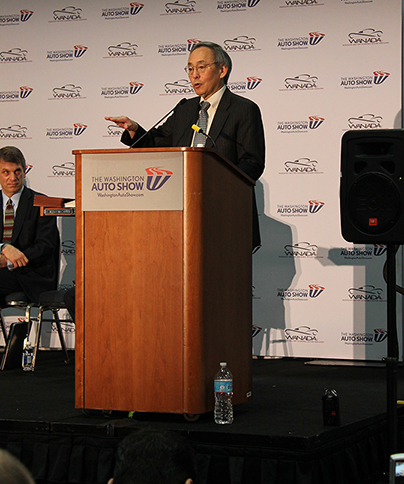Metropolitan Washington regularly finds itself at or near the top of a lot of lists. Some of these distinctions are good such as being the most educated region in the country and some of them are bad such as being one of the most expensive places to live.
Unfortunately “most electric vehicles” is not a list that we’re even near the top of – yet. The West Coast is hands down the part of the country that currently boasts the highest rates of electronic vehicle (EV) ownership.
However as we told you a few months ago when discussing a Council of Governments (COG) report on the current status of and prospects for EVs in metropolitan Washington there is great potential for growth here (the type of auto trips most common in this region fit well with the EV technology currently on the market).
Yesterday U.S. Energy Secretary Steven Chu COG’s Executive Director Chuck Bean and many others participated in the Washington Auto Show’s Public Policy Day to discuss ways to promote EVs. Secretary Chu unveiled the Workplace Charging Challenge a major expansion to the Energy Department’s EV Everywhere program.
The challenge is aimed at getting EV charging stations installed at workplaces – locations where most drivers likely park for the second longest period of time (second only to the length of time parked at home). Increasing the amount of charging infrastructure is one of the key challenges the COG report cites as necessary for scaling up EV adoption.

U.S. Energy Secretary Steven Chu discussing the EV Everywhere program at the Washington Auto Show.
And today COG hosted a forum at the Auto Show focused on making the business case for EVs. The environmental and climate benefits of EVs are clear; however as one participant noted most businesses and the general public follow “pocketbook logic” when making choices about vehicle purchases.
One panel featured representatives from companies large and small – including Capitol One MOM’s Organic Market and FedEx – discussing how and why they’re investing in EVs. One of the most interesting initiatives came from MOM’s Market which offers their employees a $5000 credit (above and beyond any federal government credits) if they choose to purchase an electric vehicle (and yes they offer free charging stations on site at their stores).
Another discussion included representatives from EV infrastructure companies and real estate developers. Mahi Reddy founder and CEO of SemaConnect acknowledged that since “filling up” for EVs currently takes an average of hours (as opposed to five minutes at the gas station) scaling up EVs will require a major change in consumer behavior (at least until charging technology improves).
“Instead of you going to the station the station must come to you” Reddy said. He also noted that the EV industry avoided some of the messiness that hampered the rise of previous technologies (see VHS vs. Betamax) by agreeing to technological standards early. This early standardization is no minor feat said Reddy emphasizing the importance of interoperability to the industry’s continued growth.